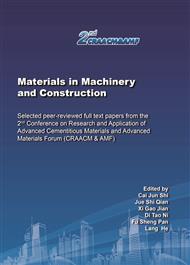[1]
H. Han,W. Wang, L. Yao, et al. Photostable 3D heterojunction photoanode made of ZnO nanosheets coated onto TiO2 nanowire arrays for photoelectrochemical solar hydrogen generation, Catal. Sci. Technol. 9 (2019).
DOI: 10.1039/c9cy00119k
Google Scholar
[2]
I. Iatsunskyi, A. Vasylenko, R. Viter, et al. Tailoring of the electronic properties of ZnO-polyacrylonitrile nanofibers: Experiment and theory, Appl. Surf. Sci. 411 (2017).
DOI: 10.1016/j.apsusc.2017.03.111
Google Scholar
[3]
N. Kilinc, O. Cakmak, A. Kosemen, et al. Fabrication of 1D ZnO nanostructures on MEMS cantilever for VOC sensor application, Sensor. Actuat. B: Chem. 202 (2014) 357-364.
DOI: 10.1016/j.snb.2014.05.078
Google Scholar
[4]
C. Han, Z. Chen, N. Zhang, et al. Hierarchically CdS Decorated 1D ZnO Nanorods-2D Graphene Hybrids: Low Temperature Synthesis and Enhanced Photocatalytic Performance, Adv. Funct. Mater. 25 (2015) 221-229.
DOI: 10.1002/adfm.201402443
Google Scholar
[5]
F. Yang, F. Wang, R. F. Jia, et al. Application Research and Progress of 0D, 1D and 2D ZnO Nanomaterials, J. Mater. Eng. 46 (2018) 20-29.
Google Scholar
[6]
A. A. Chaaya, M. Bechelany, S. Balme, et al. ZnO 1D nanostructures designed by combining atomic layer deposition and electrospinning for UV sensor applications, J. Mater. Chem. A 2 (2014) 20650-20658.
DOI: 10.1039/c4ta05239k
Google Scholar
[7]
L. S. Wang, D. Tsan, B. Stoeber. Substrate-Free Fabrication of Self-Supporting ZnO Nanowire Arrays, Adv. Mater. 24 (2012) 3999-4004.
DOI: 10.1002/adma.201200928
Google Scholar
[8]
G. W. Sears, R. Powell, B. Donn, Structure of Zinc Oxide Nuclei, 39 (1963) 2248-2251.
DOI: 10.1063/1.1701425
Google Scholar
[9]
Z. Ke-Xin, Y. Cheng-Bao, W. Xing, et al. Ultrafast nonlinear optical properties and carrier dynamics of silver nanoparticle-decorated ZnO nanowires, RSC Adv. 8 (2018) 26133-26143.
DOI: 10.1039/c8ra03027h
Google Scholar
[10]
H. M. Chiu, Y. T. Chang, W. W. Wu, et al. Synthesis and Characterization of One-Dimensional Ag-Doped ZnO/Ga-Doped ZnO Coaxial Nanostructure Diodes, Acs Appl. Mater. Inter. 6 (2014) 5183-5191.
DOI: 10.1021/am500470y
Google Scholar
[11]
J. Y.Chen, M. C. Wu, Y. H. Ting, et al. Applications of p-n homojunction ZnO nanowires to one-diode one-memristor RRAM arrays, Scripta Mater. 187 (2020) 439-444.
DOI: 10.1016/j.scriptamat.2020.06.061
Google Scholar
[12]
K. Mohammed, B. Mimouna, M. Malik. White photoluminescence from a grown ZnO nanorods/graphene hybrid nanostructure, Opt. Mater. 34 (2012) 1320-1326.
DOI: 10.1016/j.optmat.2012.02.005
Google Scholar
[13]
Y. Zong, Y. Sun, S. Meng, et al. Doping effect and oxygen defects boost room temperature ferromagnetism of Co-doped ZnO nanoparticles: experimental and theoretical studies, RSC Adv. 9 (2019).
DOI: 10.1039/c9ra03620b
Google Scholar
[14]
A. K. Das, A. Srinivasan. Evidence of oxygen defect induced ferromagnetism in heat treated electrospun ZnO nanowires, J. Magn. Magn. Mater. 404 (2016) 190-196.
DOI: 10.1016/j.jmmm.2015.12.032
Google Scholar
[15]
C. Y. Kung, S. L. Young, H. Z. Chen, et al. Influence of Y-doped induced defects on the optical and magnetic properties of ZnO nanorod arrays prepared by low-temperature hydrothermal process, Nanoscale Res. Lett. 7 (2012) 372.
DOI: 10.1186/1556-276x-7-372
Google Scholar


